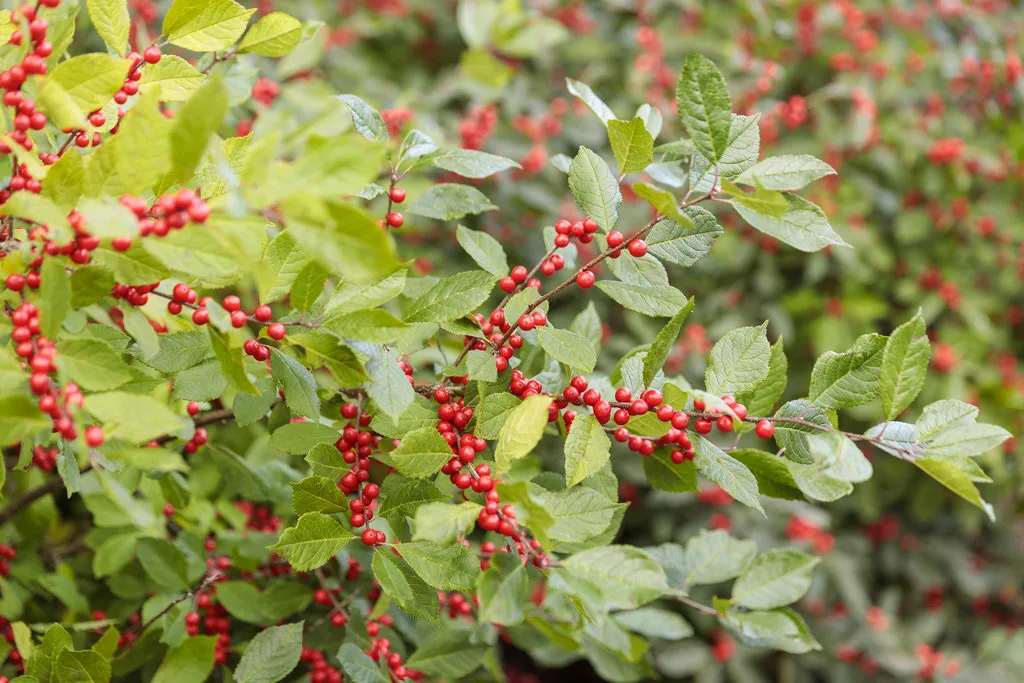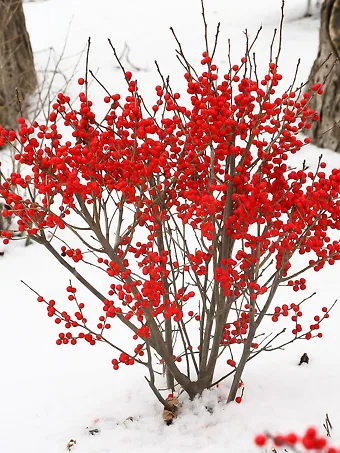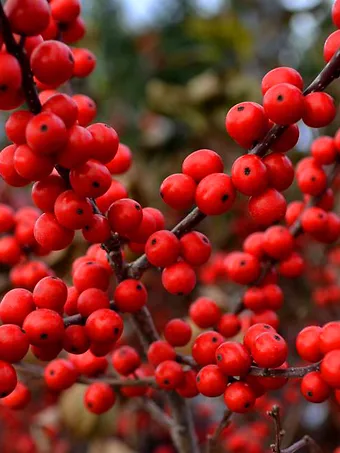
Written by s • How to Succeed with Winterberry Bushes
‘Winter’ and ‘Berries’ definitely go together. The traditional Christmas holly may dominate the Christmas card market, but as many gardeners soon discover, if you live in areas that are too cold or too hot for the evergreen hollies, it isn’t always easy to get that effect in your own garden. This is where the Winterberry comes into it’s own. Incredibly hardy even in zone 3, and yet perfectly happy in the heat and humidity of zone 9, this great native shrub has other advantages too. It stays compact and shrubby, so you can grow it even in a smaller garden. Its bare winter branches, heavy with berries, are as beautiful out in the garden as they are in a vase or worked into a wreath. It adds lots of color to the often-dreary garden through the darkest months for very little effort from us. But not everyone finds this plant easy, and the biggest complaint is that there are no berries. Since that is why we grow it in our gardens, let’s look at why this happens, and how to fix it – don’t worry, it’s easy.
The Winterberry
The Winterberry, Ilex verticillata, is a species of holly found in North America. It is distinct from the European holly, Ilex aquifolium, which features on all those Christmas cards, as well as from several evergreen American hollies, such as Ilex opaca. The main difference is that the winterberry is deciduous, but even with leaves it doesn’t look much like a holly. The leaves are ‘regular looking’, green ovals with fine serrations along the edge but no spines, and hardly leathery at all. It also grows as a bush, and while wild plants might reach 20 feet in time, garden varieties developed for abundant berries, generally stay between 3 and 5 feet tall. These varieties have winter branches smothered in bright red berries, but to make that happen a few things need to be right. Let’s see what we need to do.
-
Product on saleBerry Poppins™ Winterberry Holly$89.50
-
Product on saleBerry Heavy Winterberry Holly$79.50 – $89.50
The Male Winterberry
Like all holly bushes, winterberry comes in male and female. Almost all plants have male flower parts – the pollen – and female parts – the seeds and fruits – on the same bush, but not the holly bush. A male bush needs to be nearby for a female bush to make berries. It’s that simple. Unfortunately many nurseries carry only female hollies, because they sell well when covered in berries, and plain males are a harder sell. This is further complicated by the need for flowering to happen at the same time (obviously). With winterberry there are two distinct groups of females – northern ones, that flower early and southern ones, that flower late. This might sound back to front, but the reason for early flowering is so that they have a long season in places with cooler summers, to develop and ripen the berries.
Most winterberries are early, and the ideal male variety for pollination is ‘Jim Dandy’. If in doubt, he is your best bet. If you know you have a southern, late-flowering variety, then go for the other male called ‘Southern Gentleman’. Sometimes there are unique varieties developed for specific female trees, which matching names, but these don’t have any significant advantage over the two just mentioned. Male trees don’t have much else to offer, but their services are vital, so make sure to add at least one when you are buying a winterberry. A male can pollinate at least 5 female bushes, and some people say up to 10, so you don’t need many. Plant nearby, within 50 feet, or add one to a group planting – it’s lack of berries won’t really be noticed. The more females you have per male, the more important closeness becomes, so right among the ladies is often the best location – males love that, as we all know.
Your Plant is New
In the first winter, even if you bought a male tree, you might not see any berries. Why? Because these bushes flower early, and maybe they were no where near male trees at the nursery. It can also take a bush a couple of years to start blooming, so be patient. Once your plant is well-established and growing, those berries will soon arrive.
By the way, the tiny whitish-green flowers are not conspicuous and you might not notice them at all if you don’t look carefully. They usually come around the end of May or early June and the difference between early and late is only a couple of weeks, but it’s enough to cause problems if the varieties aren’t matched. You can tell female flowers by the green ball in the center. The picture shows female flowers. The male flower has a much smaller center, and several slender anthers topped with yellow pollen.
Location Matters Too
So you got yourself a male, and a few years have passed, and still no berries. What could be wrong? The question to ask is, “How much shade is my bush getting?” Winterberry bushes will grow pretty well in shady spots, but too much shade reduces or even eliminates flowering. You need 4 to 6 hours a day of direct sun during the growing season for success, and full sun will give the heaviest crops.
Also, this is a water-loving plant, and it enjoys moist to wet ground. Although pretty drought resistant once it has been growing for a few years, that doesn’t mean the berries will survive. The stress of dryness can cause the immature berries to fall off, or they won’t even develop at all. Water this plant generously and regularly, and use mulch if your garden is naturally a bit dry. This doesn’t mean you can’t grow winterberry in ordinary garden soil – you can. Just make sure it gets enough water.
Pruning
The simple answer to how and when to prune the winterberry is ”don’t”. Pruning will almost certainly remove berries, and too much pruning will cause vigorous, non-flowering growth to grow for a year or two. This doesn’t mean you can’t cut some branches for the holidays, but that will probably be enough to stimulate new growth that will keep your bush vigorous. If you do, in time, notice old branches that have very few berries, these can be cut out low-down, but avoid any serious pruning of young plants, and watch out for gardeners who want to take the hedge trimmers to everything!
Now Sit Back. . .
So it’s easy – have a suitable mate nearby, get at least some sun, avoid dry periods, grow naturally and be patient. That works for winterberries, and come to think of it, it’s a pretty good formula for life as well!







